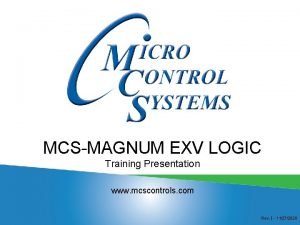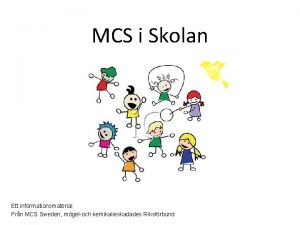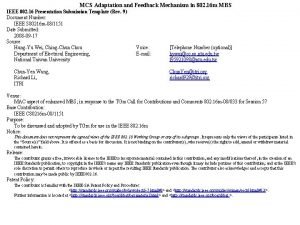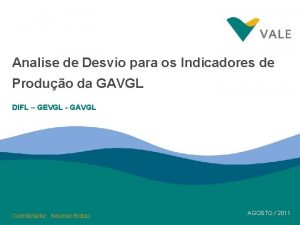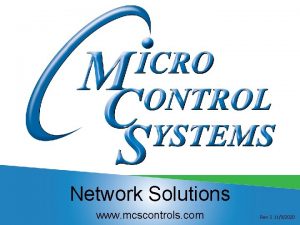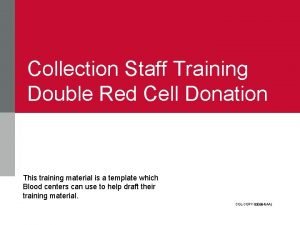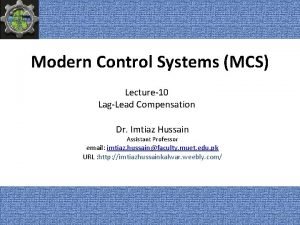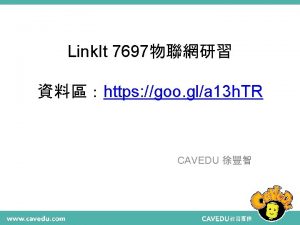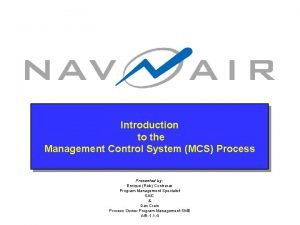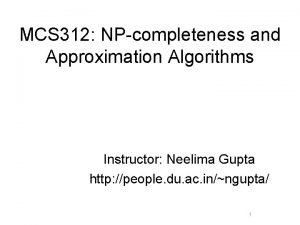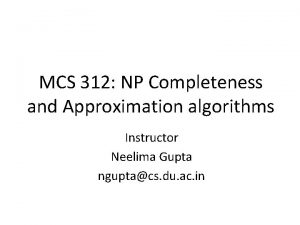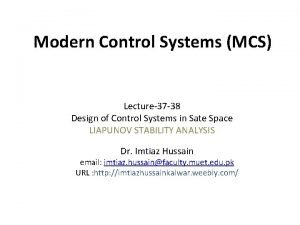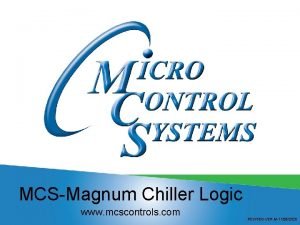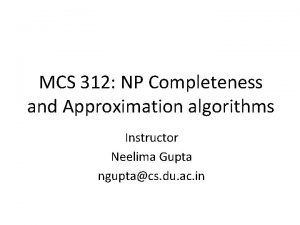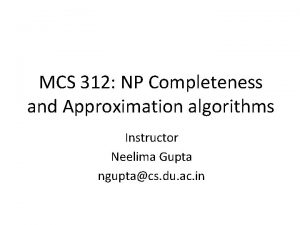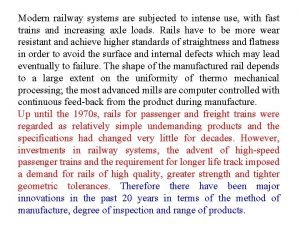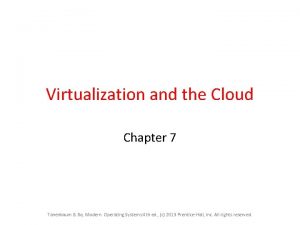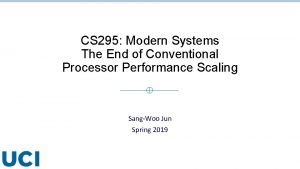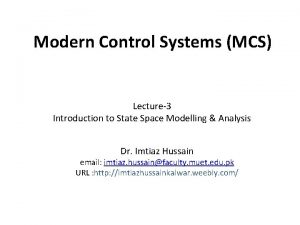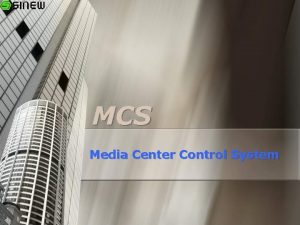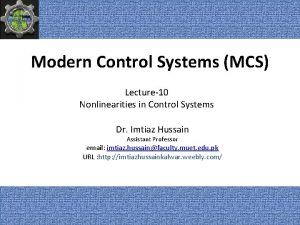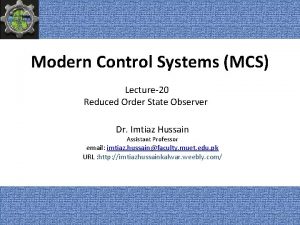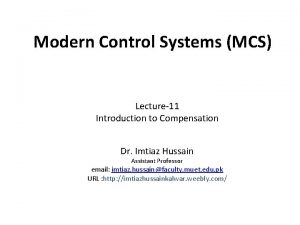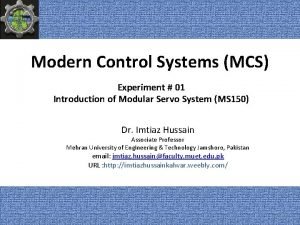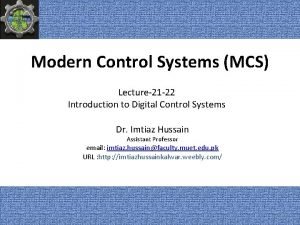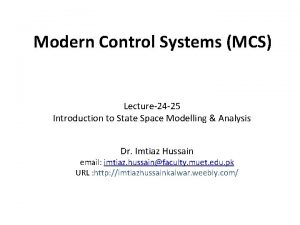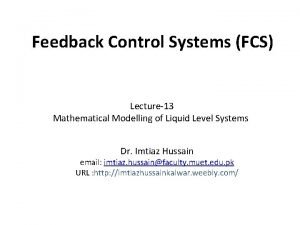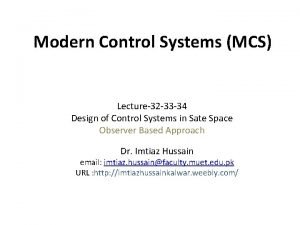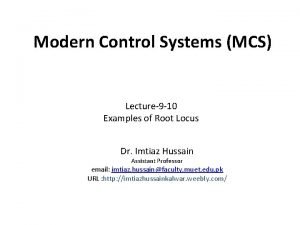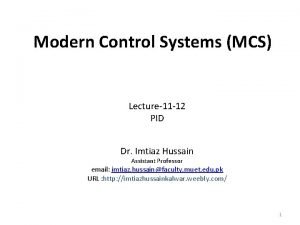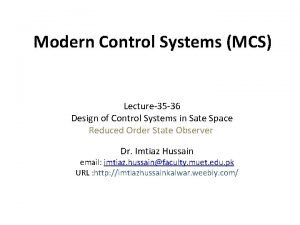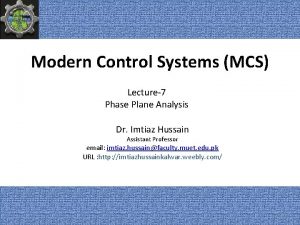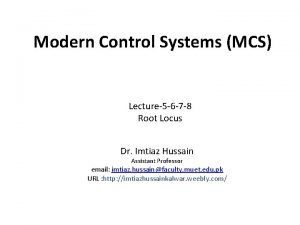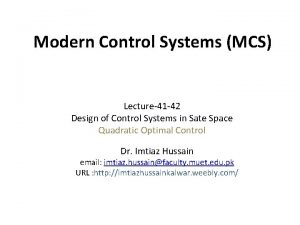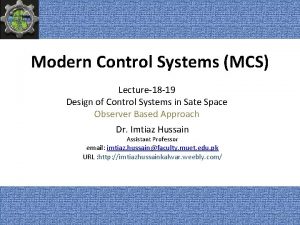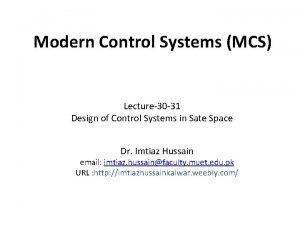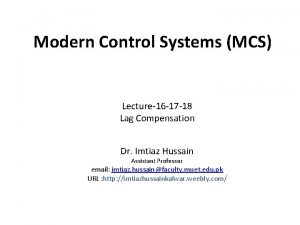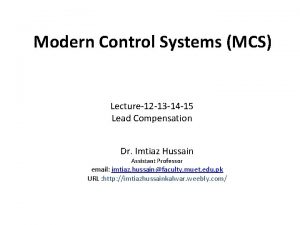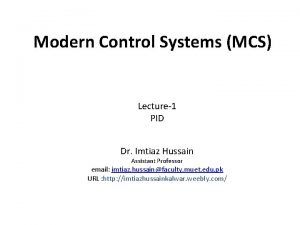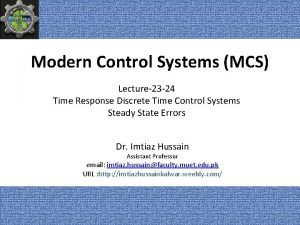Modern Control Systems MCS Lecture13 Introduction to State






























- Slides: 30

Modern Control Systems (MCS) Lecture-13 Introduction to State Space Modeling & Analysis Dr. Imtiaz Hussain email: imtiaz. hussain@faculty. muet. edu. pk URL : http: //imtiazhussainkalwar. weebly. com/

Lecture Outline • Introduction to state space – Basic Definitions – State Equations – State Diagram – State Controllability – State Observability – Output Controllability

Introduction • Modern control theory is contrasted with conventional control theory in that the former is applicable to multiple -input, multiple-output systems, which may be linear or nonlinear, time invariant or time varying, while the latter is applicable only to linear time invariant single-input, single-output systems.

Definitions • State of a system: We define the state of a system at time t 0 as the amount of information that must be provided at time t 0, which, together with the input signal u(t) for t t 0, uniquely determine the output of the system for all t t 0. • State Variable: The state variables of a dynamic system are the smallest set of variables that determine the state of the dynamic system. • State Vector: If n variables are needed to completely describe the behaviour of the dynamic system then n variables can be considered as n components of a vector x, such a vector is called state vector. • State Space: The state space is defined as the n-dimensional space in which the components of the state vector represents its coordinate axes.

Definitions • Let x 1 and x 2 are two states variables that define the state of the system completely. State (t=t 1) Velocity State Vector Position Two Dimensional State space of a Vehicle 5

State Space Equations • In state-space analysis we are concerned with three types of variables that are involved in the modeling of dynamic systems: input variables, output variables, and state variables. • The dynamic system must involve elements that memorize the values of the input for t> t 1. • Since integrators in a continuous-time control system serve as memory devices, the outputs of such integrators can be considered as the variables that define the internal state of the dynamic system. • Thus the outputs of integrators serve as state variables. • The number of state variables to completely define the dynamics of the system is equal to the number of integrators involved in the system.

State Space Equations •

• State Space Equations

State Space Modelling • State space equations can then be written as State Equation Output Equation • If vector functions f and/or g involve time t explicitly, then the system is called a time varying system.

State Space Modelling • If above equations are linearised about the operating state, then we have the following linearised state equation and output equation:

State Space Modelling • If vector functions f and g do not involve time t explicitly then the system is called a time-invariant system. • In this case, state and output equations can be simplified to

Example-1 • Consider the mechanical system shown in figure. We assume that the system is linear. The external force u(t) is the input to the system, and the displacement y(t) of the mass is the output. The displacement y(t) is measured from the equilibrium position in the absence of the external force. This system is a single-input, singleoutput system. • From the diagram, the system equation is

Example-1 • Then we obtain • Or • The output equation is

Example-1 • In a vector-matrix form,

Example-1 • State diagram of the system is -k/m -b/m 1/s 1/s

Example-1 • State diagram in signal flow and block diagram format -k/m -b/m 1/s 1/s

Example-2 • State space representation of armature Controlled D. C Motor. Ra ea La ia B eb T J t an t s n co V f= • ea is armature voltage (i. e. input) and is output.

Example-2

State Controllability • A system is completely controllable if there exists an unconstrained control u(t) that can transfer any initial state x(to) to any other desired location x(t) in a finite time, to ≤ t ≤ T. uncontrollable

State Controllability • Controllability Matrix CM • System is said to be state controllable if

State Controllability (Example) • Consider the system given below • State diagram of the system is

State Controllability (Example) •

State Observability • A system is completely observable if and only if there exists a finite time T such that the initial state x(0) can be determined from the observation history y(t) given the control u(t), 0≤ t ≤ T. observable unobservable

State Observability • Observable Matrix (OM) • The system is said to be completely state observable if

State Observability (Example) • Consider the system given below • OM is obtained as • Where

State Observability (Example) •


Output Controllability • Output controllability describes the ability of an external input to move the output from any initial condition to any final condition in a finite time interval. • Output controllability matrix (OCM) is given as

Home Work • Check the state controllability, state observability and output controllability of the following system

To download this lecture visit http: //imtiazhussainkalwar. weebly. com/ END OF LECTURES-13
 Exv driver
Exv driver Vad är mcs
Vad är mcs Feedback mcs
Feedback mcs Cisco prime collaboration deployment 12
Cisco prime collaboration deployment 12 Gavgl
Gavgl Mcscontrols
Mcscontrols Double red cell
Double red cell Jpams mcs
Jpams mcs Lag lead compensator in control system
Lag lead compensator in control system Mcs lite
Mcs lite Mcs process
Mcs process Mcs ecampus
Mcs ecampus Mcs 312
Mcs 312 Mcs 312
Mcs 312 Mcs weebly
Mcs weebly Mcs magnum controller
Mcs magnum controller Mcs 312
Mcs 312 Mcs 312
Mcs 312 S domain
S domain Digital control
Digital control Modern systems analysis and design
Modern systems analysis and design Modern railway systems
Modern railway systems Tanenbaum operating systems
Tanenbaum operating systems History of morphine
History of morphine Layers of operating system
Layers of operating system A modern approach to systems analysis and design
A modern approach to systems analysis and design A modern approach to systems analysis and design
A modern approach to systems analysis and design Modern operating systems 3rd edition
Modern operating systems 3rd edition Tanenbaum structured computer organization
Tanenbaum structured computer organization Modern systems analysis and design 7th edition
Modern systems analysis and design 7th edition Deus ex on modern systems
Deus ex on modern systems
